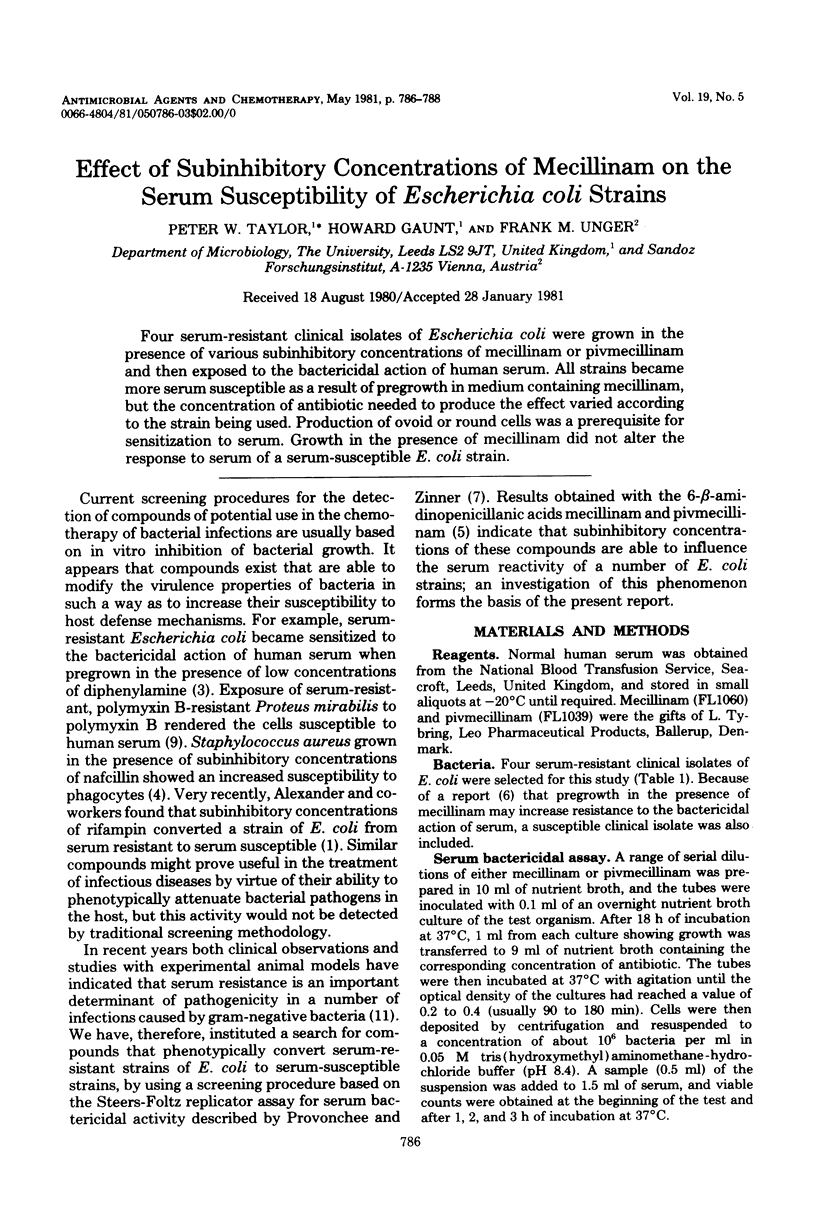Abstract
For serum-resistant clinical isolates of Escherichia coli were grown in the presence of various subinhibitory concentrations of mecillinam or pivmecillinam and then exposed to the bactericidal action of human serum. All strains became more serum susceptible as a result of pregrowth in medium containing mecillinam, but the concentration of antibiotic needed to produce the effect varied according to the strain being used. Production of ovoid or round cells was a prerequisite for sensitization to serum. Growth in the presence of mecillinam did not alter the response to serum of a serum-susceptible E. coli strain.
Full text
PDF


Selected References
These references are in PubMed. This may not be the complete list of references from this article.
- Alexander W. J., Cobbs C. G., Curtiss R., 3rd Modification of bacterial serum susceptibility by rifampin. Infect Immun. 1980 Jun;28(3):923–926. doi: 10.1128/iai.28.3.923-926.1980. [DOI] [PMC free article] [PubMed] [Google Scholar]
- Björkstén B., Bortolussi R., Gothefors L., Quie P. G. Interaction of E. coli strains with human serum: lack of relationship to K1 antigen. J Pediatr. 1976 Dec;89(6):892–897. doi: 10.1016/s0022-3476(76)80592-6. [DOI] [PubMed] [Google Scholar]
- Feingold D. S. The serum bactericidal reaction. IV. Phenotypic conversion of Escherichia coli from serum-resistance to serum-sensitivity by diphenylamine. J Infect Dis. 1969 Oct;120(4):437–444. doi: 10.1093/infdis/120.4.437. [DOI] [PubMed] [Google Scholar]
- Friedman H., Warren G. H. Enhanced susceptibility of penicillin-resistant staphylococci to phagocytosis after in vitro incubation with low doses of nafcillin. Proc Soc Exp Biol Med. 1974 Jul;146(3):707–711. doi: 10.3181/00379727-146-38177. [DOI] [PubMed] [Google Scholar]
- Godtfredsen W. O. An introduction to mecillinam. J Antimicrob Chemother. 1977 Jul;3 (Suppl B):1–4. doi: 10.1093/jac/3.suppl_b.1. [DOI] [PubMed] [Google Scholar]
- Jit Sud I., Feingold D. S. Detection of agents that alter the bacterial cell surface. Antimicrob Agents Chemother. 1975 Jul;8(1):34–37. doi: 10.1128/aac.8.1.34. [DOI] [PMC free article] [PubMed] [Google Scholar]
- Lorian V., Atkinson B. A. Effect of serum and blood on Enterobacteriaceae grown in the presence of subminimal inhibitory concentrations of ampicillin and mecillinam. Rev Infect Dis. 1979 Sep-Oct;1(5):797–806. doi: 10.1093/clinids/1.5.797. [DOI] [PubMed] [Google Scholar]
- Provonchee R. B., Zinner S. H. Rapid method for determining serum bactericidal activity. Appl Microbiol. 1974 Jan;27(1):185–186. doi: 10.1128/am.27.1.185-186.1974. [DOI] [PMC free article] [PubMed] [Google Scholar]
- Spratt B. G. The mechanism of action of mecillinam. J Antimicrob Chemother. 1977 Jul;3 (Suppl B):13–19. doi: 10.1093/jac/3.suppl_b.13. [DOI] [PubMed] [Google Scholar]
- Tybring L. Special aspects of laboratory investigations with mecillinam. J Antimicrob Chemother. 1977 Jul;3 (Suppl B):23–27. doi: 10.1093/jac/3.suppl_b.23. [DOI] [PubMed] [Google Scholar]


